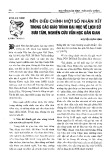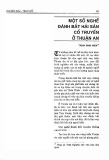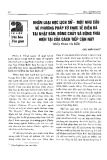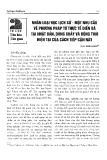C ONCLUSION: B E A G OLD M EDAL COMMUNICATOR!
manager to exert extraordinary efforts to clarify expectations and follow
up on progress in a collegial, collaborative way.
There have always been regulatory changes, and a manager can ex-
pect them to differ from year to year based on new federal and state
laws. Managers need to be knowledgeable of current regulations and any
impact on their goals and their teams.
Other changes, such as those to ergonomics, safety and security, eth-
ics, and a loss of productivity due to learning curves, all require that
managers have the ability to describe expectations and action items
clearly, listen, deal with resistance, keep morale high, and collaborate.
Communication methods such as e-mail, handheld devices, and cell
phones require continual adaptation. Many feel that managers are now
held to higher standards. They must justify their existence with tighter
financial and other metrics than ever before. Many managers must man-
age risk in the business.
Tip (cid:6)9. Influence and Persuade
Today there is a much greater emphasis on a manager’s ability to per-
suade and influence others at all levels of the organization, including
direct reports. Being directive is important at certain times and is ad-
dressed in Chapter 9 on coaching. However, being directive is no longer
the only skill a manager must have to be successful. Nor is it the most
advanced or complex. Communicating with people now requires influ-
ence and persuasion skills.
The higher level the manager, the greater the wings of influence need
to spread. To persuade, a manager hones his skills in educating others
on the benefits and logic of a project or an approach. To be convinced,
people are interested in learning the reasoning and value of what the
persuader has to say before they make up their own minds. This puts
the onus of being very clear about the whys and wherefores directly on
the shoulders of the manager. It also requires relationship building and
262—
knowing how to partner with people. This in-depth knowledge and abil-
C ONCLUSION: B E A G OLD M EDAL COMMUNICATOR!
ity to communicate is a far cry from telling employees to ‘‘just get it
done.’’
Partnering with direct reports requires a high degree of persuasion
skills to include the other person, instead of just ordering him about. By
being included, the employee’s commitment to his manager, the organi-
zation, and the work itself expands. This leads to ownership, which in-
duces employees to produce optimal results.
Influence and persuasion skills are significant communication skills
that proficient managers use to collaborate in delegating, monitoring
progress, giving feedback, and coaching.
Summary
I know that you will want to refer to this book again and again as you
master one of the communication tips and want to learn another. When
you prepare to hold a feedback, coaching, or delegating conversation
you can freshen up your approach with ideas from this book. When you
face new people problems or you want to strategize to prevent them,
return to a chapter. When you manage a new group or get promoted
and face different communication challenges, revisit the pages and the
processes. Have fun in your communication journey. As a continual
communication learner, you will open many professional and personal
doors of opportunity.
This book provides all the tips and techniques you need to ramp
up your interpersonal communication to ‘‘gold medal status.’’ Happy
—263
managing, and cheerful communicating!
This page intentionally left blank
A P P E N D I X A
Basic Job Expectations
Goals, Job Descriptions, and Performance Standards
This appendix defines three formal tools that are used to communicate
basic job expectations: goals, job descriptions, and performance stan-
dards. Two examples show how these three communication tools are
linked together.
Goals
Most employees need to understand not only what to do but also how
each responsibility fits with the larger view of the group, department,
division, and the company. This moves us to goals.
Goals are formal, measurable, written expectations. They are planned
end results or outcomes that guide individuals and groups in their re-
sponsibility to achieve their part of the corporate direction. Goals trans-
form hope and wishes into strategic direction.
Peter Drucker, renowned management consultant, introduced Man-
agement by Objectives (MBO) in 1954 in his classic book, The Practice of
Management. MBO has morphed into other ways to set goals. But the
concept of goals has withstood the test of time. They are still necessary.
Currently, many organizations use SMART goals. This acronym helps
people remember the key components of an effective goal. The written
—265
goal must be:
A PPENDIX A: B ASIC J OB E XPECTATIONS
Specific (has a desired outcome)
Measurable (through evaluation criteria—often expressed by percent,
number, or dollar amount)
Attainable (achievable, reachable even if it is a stretch goal)
Relevant (aligns with corporate objectives)
Time bound (has a target completion date)
1. Distribute news releases to three new TV news stations and three
new Internet sites by 9/30/20XX.
S–Distribute news releases (desired outcome)
M–Three new TV news stations and three new Internet sites (both the number three and the adjective new are measure- ments)
A–(manager and employee agree that they are attainable given the employee’s entire workload and the marketplace reali- ties)
R–(assume it aligns with a corporate objective to increase news
coverage)
T–9/30/20XX (target date)
2. Improve customer satisfaction during sales/service handoffs and in- stallations by 5 percent as measured by the customer survey on 12/31/ 20XX.
S–Improve customer satisfaction
M–by 5 percent
A–(assume it is a realistic increase given the time available)
R–(assume it is aligned with corporate customer service objec-
tives)
T–12/31/20XX
Examples of SMART goals are:
Job Descriptions
Job descriptions tell people what their duties are. These job descriptions
266—
list the responsibilities for a particular position, not for a particular per-
A PPENDIX A: B ASIC J OB E XPECTATIONS
son. Each accountability listed includes an action verb to depict the ac-
tivities this job requires.
Applicants usually see the job description during the prehire inter-
viewing process to help both the interviewer and the candidate assess
whether the job and the person’s qualifications are a match. Newly hired
employees then use this list of job duties as reference tools when they
begin the job. Oftentimes managers revisit the job descriptions at per-
formance appraisal time when evaluating performance against the job
duties.
Job descriptions are useful to draw the framework of activities an
employee is to accomplish. But they are general in nature and frequently
used for similar positions in many areas of the organization. They are an
excellent guideline but by no means the only way expectations are set
for most professional and managerial work.
Examples of job responsibilities on job descriptions as they relate to
For goal 1, a job responsibility could be: Writes news releases and dis- tributes them to media on subjects that may be complex; makes decisions about the news releases regarding the format of informa- tion and which media to contact.
For goal 2, a job responsibility could be: Ensures that all customer ser- vice standards are met during sales/service handoffs and installa- tions.
the two SMART goal examples:
Job descriptions are essential communication tools before and
after hiring. A manager explores a candidate’s ability to execute the
responsibilities during the interview. A manager then trains or orients
the new employee to the job, referring to the job description. When
job descriptions are revised, this calls for another clarification meeting.
Discussing the job descriptions—new or revised—is important mana-
gerial communication. The conversation about new or revised job re-
sponsibilities is a dialogue until the manager is satisfied that the
—267
employee has the same understanding as the manager about what the
A PPENDIX A: B ASIC J OB E XPECTATIONS
words on the job description mean for this specific job. Then the man-
ager reinforces the responsibilities in the weekly one-on-one or group
staff meetings when reviewing progress until they become second na-
ture to the employee.
Performance Standards
Performance standards are the parameters that employees will be evalu-
ated on in the performance appraisal. They are introduced with the job
description or whenever work is assigned. They specify what a high-
quality job will look like in terms of conditions, quality, quantity, budget,
timeliness, safety, and behaviors that contribute to teamwork and other
desired results. Depending upon the type of project or task and the level
of employee expertise, performance standards may be imposed or may
be mutually decided with the direct report.
Examples of performance standards for the two previous job respon-
For job responsibility 1: Writes news releases and distributes them to media on subjects that may be complex; makes decisions about the news releases regarding the format of information and which media to contact. > Meets specified deadlines. > Uses approved sources of information. > Gets written approval for quotes in advance of distribution. > Meets company guidelines for news releases.
For job responsibility 2: Ensures that all customer service standards are
met during sales/service handoffs and installations. > Follows company service standards and procedures completely. > Completes service agreement forms and documents any prom-
ises to meet the individual needs of the customer.
> Ensures that solutions are mutually acceptable and signed off on by the customer, the sales manager, and the customer service manager.
268—
sibilities are:
A PPENDIX A: B ASIC J OB E XPECTATIONS
> Completes and submits reports that track progress, including, but not limited to, daily, weekly, and monthly sales call plans, ap- pointments, and orders obtained.
> Provides accurate and complete information. > Uses company format. > Meets deadlines for each report.
The more specific the performance standards are, the better the
chance the employee has for success. When managers are not clear on
the performance standards, the employee often cannot be given excel-
lent ratings. This is because the manager can’t define ‘‘fully satisfactory,’’
much less ‘‘excellent.’’ Frequently this lack of clarity leads to misunder-
standings, lack of trust, and decrease in morale. Employees may feel that
they cannot succeed because success cannot be defined; the perfor-
mance rating might be designated based on gut feel, which is not pre-
dictable.
When managers determine performance appraisal ratings, they are
using performance standards. The standards may be formal, written, and
discussed. Or they may be personal to the manager, informal, unwritten,
and not discussed. Managers must measure observable results against a
yardstick of some sort. The more openly discussed and clarified, the eas-
ier it is for the employee to achieve and thus stay motivated. It also pre-
vents surprises on performance reviews.
Oftentimes I have heard from managers that their bosses do not give
excellent ratings. In one particular management class, a woman stated
that her boss never gave anyone an excellent rating on a performance
evaluation. He said no one is ever excellent. She said she’d gotten used
to it and was now applying that dictate to her staff. She also said it upset
her and her staff and had negative effects. Since employees were frus-
trated that they could not achieve greatness, they did not give extra effort
to make results excellent. She felt the quality of the work was less than it
could have been with no incentive to go above and beyond. Other class
—269
participants said they would leave a boss who refused on principle to
A PPENDIX A: B ASIC J OB E XPECTATIONS
give excellent ratings. They said it is demoralizing to know you can never
earn a top rating.
The boss in question confuses ‘‘people’’ with ‘‘performance stan-
dards and results.’’ It’s true that humans are not perfect, but that is not
what is at stake in setting performance expectations and evaluating
against them. Job responsibilities and performance standards are spe-
cific to a job, not to a person. If the results exceed the basic require-
ments, then the performance can be rated excellent. The person may not
be considered perfect, but it is the work that is being evaluated, not the
270—
person.
APPENDIX B
Communication Issues Unique to First-Time Managers
First-time managers experience special challenges, especially when it
comes to communication. The two main problem areas are (1) handling
the dual roles of being both a manager and an individual contributor
simultaneously and (2) making the transition to being a manager. This
appendix includes action steps to handle some typical issues that arise,
including:
? How to strike a balance between functioning as a manager and an
individual contributor
? How to handle problem managing peer with greater seniority and
experience
? Time management (balancing time for direct reports and managerial
work)
Dual Roles
? Transitioning from an individual contributor to a manager role ? How to prove capable in new role ? How to get comfortable managing people
Transition to Being a Manager
Dual Roles—Being Both a Manager and an Individual Contributor Simultaneously
A trend today is that many first-time managers are required to function
—271
in two roles. They are expected to continue in their technical individual


























